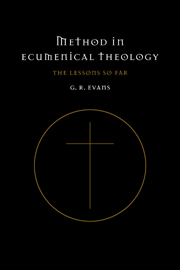Book contents
- Frontmatter
- Contents
- Dedication
- Preface
- Abbreviations
- Introduction: the ‘winter of ecumenism’?
- I What is ecumenical theology?
- 2 Changing attitudes and stages in ecumenism
- 3 Communication and dialogue
- 4 Ecumenical language
- 5 Historical method
- 6 The process in close-up
- 7 Ecumenical reception
- Conclusion
- Index
Introduction: the ‘winter of ecumenism’?
Published online by Cambridge University Press: 02 September 2009
- Frontmatter
- Contents
- Dedication
- Preface
- Abbreviations
- Introduction: the ‘winter of ecumenism’?
- I What is ecumenical theology?
- 2 Changing attitudes and stages in ecumenism
- 3 Communication and dialogue
- 4 Ecumenical language
- 5 Historical method
- 6 The process in close-up
- 7 Ecumenical reception
- Conclusion
- Index
Summary
In the late 1960s it began to look as though it would be possible to achieve within our lifetimes a definitive coming together in unity between a number of the existing separated communions. After the Second Vatican Council
rapid developments in the doctrinal dialogues initiated at the request of the protestant observers at Vatican II, and encouraged by Pope Paul VI, showed that substantial agreements could be reached in areas that had seemed to be insurmountable barriers … the progress of the bilateral doctrinal dialogues indicated that the Churches of the Reformation and the Roman Catholic Church could be reconciled at least to the extent that the reasons for the original division were resolvable … those involved in the dialogues began to hope that Christian unity might actually be achieved within a generation.
But in many cases the churches which joined in this enterprise so eagerly at first are not proving able to make wholeheartedly their own the agreements arrived at through the dialogues; and consequently they cannot act out such agreements in actually moving towards union. When it comes to turning the (real enough) experience of mutual affection into ecclesial union, everything stops short and the parties tend to retreat towards the familiar ground of their life in division.
Parallels with recent experience in the European Union irresistibly suggest themselves.
Information
- Type
- Chapter
- Information
- Method in Ecumenical TheologyThe Lessons So Far, pp. 1 - 18Publisher: Cambridge University PressPrint publication year: 1996
